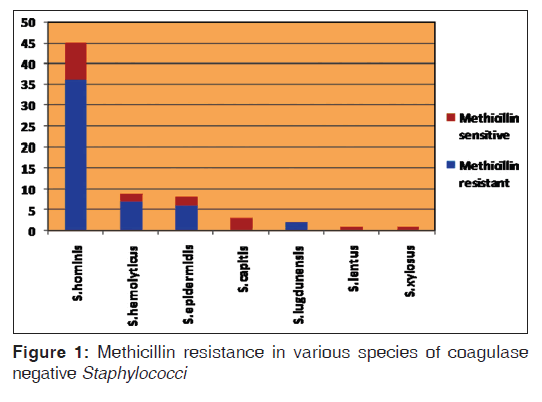Staphylococcal Blood Stream Infections in Cancer Patients
- *Corresponding Author:
- Ahmed NH
Departments of Microbiology and Clinical Oncology, Delhi State Cancer Institute, New Delhi, India
E-mail: drnishathussain@rediffmail.com
Abstract
.
Dear Sir,
Cancer patients are at an increased risk of the blood stream infections (BSI) due to their immune-compromised status, repeated hospitalizations, and various procedures. Staphylococci, particularly coagulase negative Staphylococci (CoNS) are noteworthy pathogens in such cases, and the emergence of multi-drug resistance in Staphylococci is a cause of concern. This study was prospectively conducted over a period of 8 months at a cancer institute located in North India to know the prevalence and antimicrobial susceptibility pattern of Staphylococci causing BSIs.
All blood culture samples received from patients suspected of having BSI were incubated in BacT/Alert 3D system (BioMe’rieux, Durham, North Carolina/USA). Subcultures were performed from the bottles flagged as positive. Identification and antibiotic susceptibility of the Gram-positive cocci isolated were carried out in VITEK 2-Compact© system (BioMe’rieux, North Carolina/USA) using GP-ID and AST-P628 cards respectively. The resistance patterns of all Staphylococci identified as pathogens were analyzed.
Out of total 512 blood samples received, 157 (30.7%) were flagged as positive. Totally, 77 out of 157 (49%) grew Gram-positive organisms, 39 (24.8%) grew Gram-negative organisms and one grew Candida albicans on subculture.
Staphylococci accounted for 96.1% (74/77) of all Gram-positive isolates with five Staphylococcus aureus and 69 CoNS spp. isolates [Table 1]. There were 2.6% (2/77) isolates of Enterococcus faecalis and 1.3% (1/77) isolates of Kocuria kristinae.
| Staphylococcal isolates | Number(%) | Number of methicillin resistant isolates (%) | Number of patients who expired (%) | |
|---|---|---|---|---|
| Staphylococcus aureus | 5 | (6.8) | - | - |
| CoNS | ||||
| Staphylococcus hominis | 45(60.8) | 36 (80) | 8 (17.8) | |
| Staphylococcus hemolyticus | 9 (12.2) | 7 (77.8) | 3 (33.3) | |
| Staphylococcus epidermidis | 8 (10.8) | 6 (75) | 1 (12.5) | |
| Staphylococcus capitis | 3(4.1) | - | - | |
| Staphylococcus lugdunensis | 2(2.7) | 2 (100) | - | |
| Staphylococcus lentus | 1(1.4) | 1 (100) | 1 (100) | |
| Staphylococcus xylosus | 1(1.4) | 1 (100) | - | |
| Total | 74 | 53 | 13 | |
Table 1: Details of the Staphylococci isolated from BSI
All isolates of S. aureus were resistant to penicillin and were beta lactamase positive, all of them were methicillin sensitive. About 86.9% of CoNS were resistant to penicillin and 15.9% were β-lactamase positive. Methicillin resistance varied with species of CoNS as shown in Figure 1. Average resistance to methicillin was 71% in all CoNS isolates, which is much higher than previously reported.[1]
Resistance of the Staphylococcal isolates to other antibiotics is shown in Table 2. All isolates of S. aureus were resistant to ciprofloxacin while none were resistant to clindamycin, vancomycin, linezolid, tigecycline and daptomycin. 23.2% of the CoNS isolates were resistant to clindamycin (11.6% inducibly resistant and 11.6% inherently resistant). Four (5.8%) isolates of CoNS were intermediately sensitive to teicoplanin while one (1.4%) was completely resistant. Reduced susceptibility of CoNS from BSIs to glycopeptides has been previously reported by Silvia et al.[2] All the CoNS isolates were sensitive to vancomycin, linezolid, tigecycline, and daptomycin.
| Organisms | Penicillin | Gentamicin | Ciprofloxacin | Levofloxacin | Erythromycin | Clindamycin | Daptomycin | Linezolid | Vancomycin | Tigecycline | Teicoplanin |
|---|---|---|---|---|---|---|---|---|---|---|---|
| Staphylococcus aureus |
100 | 0 | 100 | 100 | 40 | 0 | 0 | 0 | 0 | 0 | 0 |
| CoNS | 86.9 | 15.9 | 62.3 | 32.3 | 79.7 | 23.2 | 0 | 0 | 0 | 0 | 1.4 |
CoNS: Coagulase negative Staphylococci, BSI: Blood stream infections
Table 2: Antibiotic resistance pattern (%) of Staphylococci in BSIs
Out of 74 patients who had Staphylococcal bacteremia, 13 patients had a fatal outcome (Crude mortality rate = 17.6%). Two of the patients who expired had hematological cancer while the rest 11 patients suffered from solid cancers, and two patients had neutropenia.[3]
This study shows that Staphylococci, particularly CoNS are responsible for a significant number of BSIs in cancer patients. In the present study, Staphylococcus hominis (60.8%) was the most common Staphylococcal isolate followed by Staphylococcus hemolyticus (12.2%) and Staphylococcus epidermidis (10.8%). High level of methicillin resistance and resistance to first and second-line antibiotics was seen. Reducing susceptibility to teicoplanin was also observed. Susceptibility was maintained to the life-saving antimicrobials like vancomycin, linezolid, and tigecycline.
To conclude, CoNS are important pathogens causing BSI in cancer patients. The high level of methicillin and multidrug resistance and reducing susceptibility to teicoplanin are causes of concern as they further narrow down the therapeutic options in already difficult to treat BSIs in such patients due to their immune-compromised status.
References
- Tak V, Mathur P, Lalwani S, Misra MC. Staphylococcal blood stream infections: Epidemiology, resistance pattern and outcome at a level 1 Indian trauma care center. J Lab Physicians 2013;5:46-50.
- Natoli S, Fontana C, Favaro M, Bergamini A, Testore GP, Minelli S, et al. Characterization of coagulase-negative staphylococcal isolates from blood with reduced susceptibility to glycopeptides and therapeutic options. BMC Infect Dis 2009;9:83.
- Longo DL. Leukocytosis and leukopenia. In: Fauci AS, Braunwald E, Kasper DL, Hauser SL, Longo DL, Jameson JL, et al., editor. Harrison’s Manual of Medicine. 17th ed. New York: McGraw Hill; 2009. p. 329-32.





 The Annals of Medical and Health Sciences Research is a monthly multidisciplinary medical journal.
The Annals of Medical and Health Sciences Research is a monthly multidisciplinary medical journal.